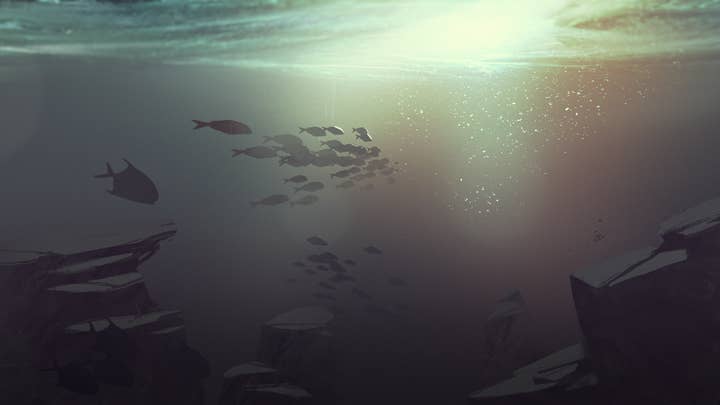Why Giant Sparrow built What Remains of Edith Finch without a detailed plan
“It was much easier just to start building prototypes and figure it out from there”
For narratively intricate titles like What Remains of Edith Finch, you might expect the structure to be planned out in extensive detail before a single line of code is written.
But in the case of Giant Sparrow's acclaimed adventure, things started out very differently. Having achieved success with its first title, PlayStation exclusive The Unfinished Swan, the team was determined to maintain its reputation with a second game and that required a different approach to development.
Speaking to GamesIndustry.biz, creative director Ian Dallas said the biggest lesson learned from working on the colour-themed exploration game was "not to have a very detailed plan."

"For the kinds of games we make where we're trying to create something we've never seen before, it's easier just to start building prototypes and figure it out from there," he says. "As long as there's a very clear goal, it's faster and more fun to jump in and get something playable.
"It's amazing how long you can spend talking to people about an idea and feel like you all understand each other, but as soon you make something and let them play it they're like, 'Ooooh! That's what you meant!' So rather than plan it all ahead of time, we do it over time, using the prototypes as tools for all of us to consider the issues and discuss them.
"The hard part is figuring out how much time to spend, and how many other departments to get involved, at each stage of the prototype. Sometimes a bit of extra art or animation support can make it all gel and be very helpful for everyone, but often you're going to be throwing everything away before you start the next prototype, so it's always a balancing act."
As long as there's a very clear goal, it's faster and more fun to jump in and get something playable
Launching today on Xbox One, What Remains of Edith Finch has already become one of this year's most talked about independent titles. It puts players in the role of Edith Finch Jr, the last of the Finch family as she explores her home and learns about the mysterious curse that has brought about the untimely deaths of her various relatives.
Dallas says the goal was to evoke "the feeling of the sublime", hoping to create a game riddled with "moments where you encounter something simultaneously beautiful but also overwhelming". The initial inspiration for this came from his own childhood.
"For me the clearest memory of that was Scuba diving as a kid, and seeing the bottom of the ocean slope away into a seemingly infinite darkness," he says. "When we started working on the game, we began by making a Scuba diving simulator but we found it got kind of dull after a couple of minutes, or at least that it felt a bit too much like a traditional game, so started exploring other ideas."
The narrative, meanwhile, was inspired by multiple works although Dallas cites one book as the team's primary reference: One Hundred Years of Solitude, the 1967 novel by Gabriel García Márquez. It's a literary outing he praises for its ability to "blend magical and realistic elements" and the skill with which the author "weaves a story through many generations of a family" - something that can instantly be recognised in the game's exploration of the Finches' history.
To further capture that sense of the sublime, Giant Sparrow turned to 'weird fiction' - a 1930s genre of literature that includes works by notable authors such as H.P. Lovecraft and Arthur Machen. Weird fiction stories often deal with "what it feels like to be in a universe that's stranger than you can possibly imagine", as Dallas puts it, but it wasn't just the tone that inspired the team. The structure, often focused around shorter narratives, would later inform the decision to build What Remains of Edith Finch as a collection of stories rather than a single plot.
Short stories leaves a stronger and more mysterious impression. They also draw more attention to the fact that what you're experiencing is not necessarily the truth
"A lot of our favourite [weird fiction] stories were quite short, and I think for powerful feelings like the sublime, it's just easier to get in and get out quickly," says Dallas. "It leaves a stronger and more mysterious impression.
"Short stories also draw more attention to the fact that what you're experiencing is a story and not necessarily the truth. It's one person's version of what might have happened. Often in weird fiction, or in fantastical tales like The Arabian Nights, it's not only stories, it's stories-within-stories, which adds a nice sense of ambiguity and energy."

What Remains of Edith Finch is the latest in an increasingly long line of independently developed titles that launch to critical acclaim, win multiple awards and commercially perform well enough to at least partially fund the studio's next product - but sadly such games rarely sell in the millions that many would hope. Critics would have you believe these are the titles driving our medium forward, but the mainstream audiences they might appeal to are rarely aware of them. Does Dallas believe there's anything the industry could do to better support such games?
I personally had no idea that so many players would be moved to tears. I underestimated how emotionally open many players are when they sit down with a game
"That's a good question that I don't have an answer for," he says. "We've been very fortunate to find a publisher who was more driven by making critically successful games than commercially successful ones. I mean, you always hope to do both, but we weren't primarily driven by selling the most copies of a game. And that's rare. Like I said, we've been lucky."
The publisher in question is Annapurna Interactive, a closely-watched contender that is behind some of the most anticipated indie titles to be announced in the last few months - including Xbox One exclusives The Artful Escape and Ashen. The firm's faith in Giant Sparrow helped drive What Remains of Edith Finch to the critical success it has enjoyed, but it's the public reception Dallas is most pleased with.
"It has been surprisingly positive and heartfelt," he says. "I personally had no idea that so many players would be moved to tears. I never expected that an experience that, to me, feels so strange and idiosyncratic would connect in such a personal way with many players. I underestimated how emotionally open many players are when they sit down with a game, that they're willing to let it take them to some very difficult places.
"I think the whole team is proud of what we managed to do with this game. It was touch and go for quite a while, so seeing it all come together so well is very satisfying. And there's a big sense of relief, at least for me."
Of course it helps that the gaming community has become much more receptive to story-driven titles, from Fullbright's seminal Gone Home to the collected award-winning works of The Chinese Room. It is a trend Dallas and the Giant Sparrow team welcome, and one that presents opportunities to ambitious developers everywhere.
Ten years ago if you were making a first-person game with no guns, you'd spend most of your time talking to players and press about that
"Players are becoming more open to trying things they haven't experienced before," Dallas observes. "I think part of that is because they've gotten a little bored with how similar many games have become and part of it is that there have been some really well-made games in the last couple of years that rewarded their curiosity, so they're happy to roll the dice again."
He continues: "As a developer, it's a lot easier to make a game when you don't have to constantly be defending it. Ten years ago if you were making a first-person game with no guns, you'd spend most of your time talking to players and press about that. You'd run out of time to tell people what was actually special and worth experiencing about your game.
"It's much easier now. The term 'walking simulator' means different things to different people, but even when it's used negatively now I think it's meant dismissively, like 'Oh, that's a game I wouldn't personally enjoy', whereas a few years ago it felt more like 'Oh, that's a game that shouldn't exist'. Now that we have a little breathing room, we can get down to business and start making seriously weird stuff."

And it's a trend he expects to continue accelerating as the range of people making games continues to increase, helped in no small part by the lowering barrier to entry for both hopeful creatives and more experienced indie devs.
"Games will become more diverse as game developers become more diverse," says Dallas. "To some extent, that's just a matter of time as more kids grow up playing games and the tools for making them become more accessible. Historically, games have been so technically challenging to make that most game developers had to be very technical people, but all of that is changing quickly."
If I could give them once piece of advice for making a game like this it would be: don't.
While Dallas is immensely proud of his team's accomplishments with What Remains of Edith Finch, he expects a less frantic development process on whatever Giant Sparrow decide to make next. Not having a detailed plan may have worked out in this instance, but one factor made this a lot tougher than expected: the size of the team.
"Next time around, we're going to start with a smaller group of people and grow at a much slower pace," says Dallas. "Even though moving ahead without a clear plan and figuring it out as we went along worked out well for us in the end this time, with each person we added to the team it got harder.
"If you've got five artists on staff, then just figuring out what those folks should be making this week - as well as finding photo references, doing reviews, and so on - can become a full-time job for a level designer. But there does come a day when you need those five artists to all be making stuff, otherwise you'll never fill up all these ridiculously detailed bedrooms you've designed. It's tricky."
What Remains of Edith Finch is yet another example of a studio attempting to make something different, a title unlike the majority of games on the marketplace. Like so many indie hits, it will no doubt inspire other creators who wish to make their mark on the industry - but Dallas stresses that developers shouldn't become too focused on reinventing the wheel.
"If I could give them once piece of advice for making a game like this it would be: don't," he says. "It's crazy to make a game that has a dozen other smaller games inside it, and try to weave them all together into something that feels cohesive. Nobody should do that. Especially when there are so many other interesting, easier ideas for games.
"For people who are interested in new ways of telling stories, I'd encourage them to forget about that as well. Don't worry about it. Just find something very small and focused that's really compelling to you. I think too many people are worried about how to tell their story, rather than focusing on what story you're trying to tell. If you have something unique to say, and you spend enough time exploring that idea and what it means to you, you'll find a unique way of expressing it."






.jpg?width=291&height=164&fit=crop&quality=80&format=jpg&auto=webp)

